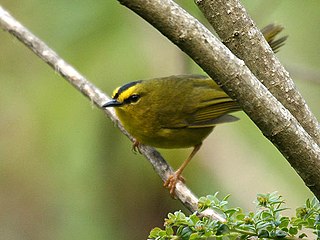
The New World warblers or wood-warblers are a group of small, often colorful, passerine birds that make up the family Parulidae and are restricted to the New World. The family contains 120 species. They are not closely related to Old World warblers or Australian warblers. Most are arboreal, but some, like the ovenbird and the two waterthrushes, are primarily terrestrial. Most members of this family are insectivores.

The golden-crowned warbler is a small New World warbler.

A mixed-species feeding flock, also termed a mixed-species foraging flock, mixed hunting party or informally bird wave, is a flock of usually insectivorous birds of different species that join each other and move together while foraging. These are different from feeding aggregations, which are congregations of several species of bird at areas of high food availability.

The black-cheeked warbler is a New World warbler, resident breeding bird endemic to the Talamancan montane forests of Costa Rica and western Panama.

Basileuterus is a genus of New World warblers, best represented in Central and South America. This is one of only two warbler genera that are well represented in the latter continent. Some species formerly considered in this genus are now placed in the genus Myiothlypis. It is likely that the ancestors of this genus colonised South America from the family's heartland in northern Central America even before the two continents were linked, and subsequent speciation provided most of the resident warbler species of that region.

Whitestarts are New World warblers in the genus Myioborus. The English name refers to the white outer tail feathers which are a prominent feature of the members of this genus. The species in this genus are also often called "redstarts".

The Santa Marta warbler is a species of bird in the family Parulidae. It is endemic to the Santa Marta Mountains in Colombia.

The golden-browed warbler is a species of bird in the family Parulidae, the New World warblers. It is found in El Salvador, Guatemala, Honduras, and Mexico. Its natural habitat is subtropical or tropical moist montane forests. The species was described by Jacob Post Giraud, Jr. in 1841.

The russet-crowned warbler is a species of bird in the family Parulidae. It is found in Bolivia, Colombia, Ecuador, Peru, and Venezuela. Its natural habitats are subtropical or tropical moist montane forests and heavily degraded former forest.

The grey-headed warbler is a species of bird in the family Parulidae. It is endemic to Venezuela.

The white-bellied warbler is a bird in the family Parulidae. It is found in Bolivia, Brazil, and Paraguay. It resembles the closely related golden-crowned warbler, but its underparts are entirely whitish instead of yellow. Recently, the South American Classification committee of the AOU reclassified the white-bellied warbler as a subspecies of the golden-crowned warbler based on studies by Lovette et al. and Vilaca and Santos.

The Pirre warbler is a species of bird in the family Parulidae. It is found in the borderline area of Panama and Colombia . Its natural habitat is subtropical or tropical moist montane forests. It is threatened by habitat loss.

The three-banded warbler is a species of bird in the family Parulidae. It is found in Ecuador and Peru. Its natural habitats are subtropical or tropical moist montane forests and heavily degraded former forest.

The three-striped warbler is a species of bird in the family Parulidae. It was previously considered conspecific with the Tacarcuna warbler and the black-eared warbler. This bird is found in South America from Venezuela to Peru. The Yungas warbler was previously considered a subspecies.

Myiothlypis is a genus of New World warblers, best represented in Central and South America. This is one of only two warbler genera that are well represented in the latter continent. All of these species were formerly placed in the genus Basileuterus.

The black-eared warbler or Costa Rican warbler is a species of bird in the family Parulidae. It was previously considered conspecific with the three-striped warbler and the Tacarcuna warbler.

The Eastern Panamanian montane forests (NT0122) is an ecoregion in the east of Panama and the extreme northwest of Colombia. It contains diverse flora and fauna, with considerable endemism. The ecoregion is largely intact due to its inaccessibility, although the opening of an extension of the Pan-American Highway has introduced threats from human activity.

The Yungas warbler is a species of bird in the family Parulidae. It was previously considered conspecific with the three-striped warbler. This bird is found in South America from southeastern Peru to southcentral Bolivia.

The Roraiman warbler is a species of passerine bird in the new world warbler family Parulidae. It is known to associate with Tepui rainforest ecosystems and is found in southern Venezuela, western Guyana, and adjacent areas of northern Brazil. The bird has been periodically granted full species status, although it has also been occasionally considered a subspecies of two-banded warbler. Based on the population's physically disparate distance from the nominate species, vocal differences, and slight differences in plumage, several authorities consider the Roraiman warbler independent. Recent genetic evidence also indicates the birds of northern South America are significantly diverged from the two-banded warbler populations in the Andes.


















